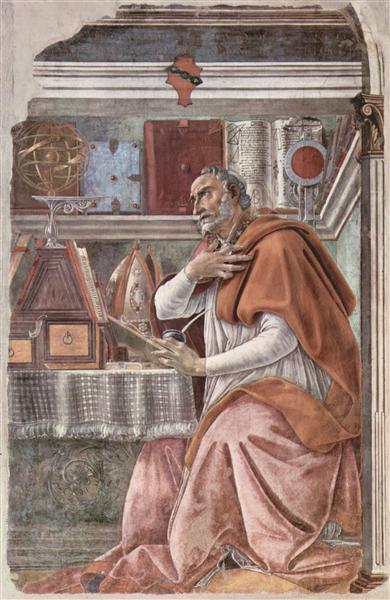Opis
Obraz „San Agustín” Sandro Botticelli, wykonany w 1480 r., Jest dziełem bogatym w symbolikę i technikę, która obejmuje zarówno religijną zapał włoskiego renesansu, jak i pojedynczy talent florenckiego nauczyciela. Botticelli, znany ze swojego mistrzostwa w użyciu koloru i linii, przedstawia reprezentację św. Augustyna, który jest jednym z rodziców Kościoła i centralną postacią w teologii chrześcijańskiej. Praca jest nie tylko portretem świętego, ale także medytacją o duchowości i wiedzy.
Z kompozycyjnego punktu widzenia Botticelli umieszcza św. Augustyna w środowisku, które przywołuje głębokie połączenie z boskością. Postać świętego jest na dominującym pierwszym planie, ubrany w szatę i warstwę, która oznacza jego status kościelny. Jego, przemyślany i kontemplacyjny wygląd sugeruje głęboką introspekcję, podczas gdy jego lewa ręka zawiera książkę, symbol wiedzy, którą można interpretować jako odniesienie do jego pism teologicznych, zwłaszcza „wyznania”. Postawa i wyraz św. Augustyna odzwierciedlają jego rolę głębokiego myśliciela i kontemplatora wiary.
Paleta kolorów zastosowana w farbie jest charakterystycznie bogata, z strasznymi tonami połączonymi ze złotymi i ostrymi akcentami. Botticelli używa szeregu ochry i brązu dla ponurego tła, tworząc kontrast z białą ubraniem świętego, która podkreśla jego postać i ustala poczucie jasności. To użycie koloru stanowi niemal eteryczną atmosferę sceny, co sugeruje związek między ziemskimi a boską. Ponadto zarządzanie światłem w pracy wzmacnia ideę duchowego objawienia; Światło wydaje się owinąć świętego, podkreślając jego znaczenie.
Fascynujący detal to tło, które jest prezentowane jako ciemna powierzchnia bez wielu elementów, które odwracają uwagę widza. Jednak ta prostota zapewnia postać San Agustína monumentalność, która podnosi ją powyżej światowego kontekstu, pozwalając zarówno jej charakter teologiczny, jak i ludzkość wyróżnić się w kompozycji. Botticelli, często kojarzone z bardziej dekoracyjnym i liniowym stylem, w tej pracy pokazuje jego zdolność do łączenia elementów symboliki z niemal rzeźbiarską strukturą.
Wpływ filozofii neoplatowej renesansu jest dowodzony w tej pracy, która szuka doskonałej prawdy poprzez boską wiedzę. San Agustín, obrońca tego poszukiwania prawdy, staje się pojazdem do odkrywania tych pomysłów. Ikonografia tej pracy jest w szerszym kontekście włoskiego renesansu, w którym poszukiwano syntezę wiary a rozumem, coś, co Botticelli po mistrzowsku zastanawia się nad postacią św. Augustyna.
Chociaż obraz nie obejmuje wyraźnie innych postaci, samotna obecność San Agustín zachęca widza do zastanowienia się nad jego wyjątkowością jako myśliciela i świętego. Jego reprezentacja podkreśla nie tylko jego znaczenie jako postaci religijnej, ale także jako symbol wiedzy i mądrości, które były wówczas bardzo cenione.
„San Agustín” Botticelli to coś więcej niż portret; Jest to synteza przeszukania duchowego i pytania filozoficznego, które zdefiniowało renesans. Merced swój skład, delikatne zarządzanie kolorem i symboliczną głębię, praca rezonuje nawet dzisiaj, przypominając nam o odpowiednim przecięciu wiary, filozofii i poszukiwania wiedzy. We współczesnym świecie pełnym rozproszenia obraz św. Augustyna zachęca nas do głębszej i bardziej znaczącej kontemplacji o celu i ścieżce wiedzy duchowej.
KUADROS ©, słynna farba na ścianie.
Ręcznie wykonane obrazy olejne, z jakością profesjonalnych artystów i charakterystyczną pieczęcią KUADROS ©.
Usługa reprodukcji zdjęć z gwarancją satysfakcji. Jeśli nie jesteś w pełni zadowolony z repliki twojego obrazu, zwrócimy twoje pieniądze w 100%.

